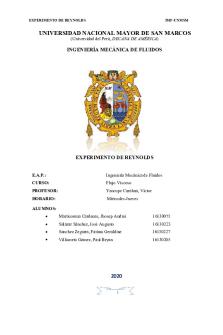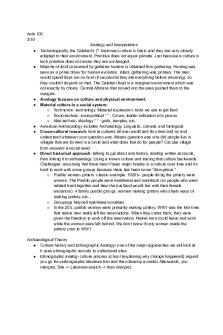The Reynolds Analogy PDF

| Title | The Reynolds Analogy |
|---|---|
| Author | Mojtaba Afzali |
| Course | Energy and Environmental Technology |
| Institution | Universitetet i Sørøst-Norge |
| Pages | 12 |
| File Size | 422.9 KB |
| File Type | |
| Total Downloads | 82 |
| Total Views | 156 |
Summary
Download The Reynolds Analogy PDF
Description
www.usn.no
Report, Transport Processes, 2019
The Reynolds Analogy
Mojtaba Afzali Student number 230769
www.usn.no
Preface In this report the focus is on the Reynolds Analogy as assignment of course Transport Process by Professor Lars-Andre Tokheim in faculty of technology of the South-Eastern of Norway university (USN). The course is part of Master of Science Energy and Environmental Technology (EET). I try to explain and describe everything simple for deeper understanding. “ If you can’t explain it simply, you don’t understand it well enough” (Albert Einstein)
Porsgrunn, 01.11.2019 Mojtaba Afzali
www.usn.no
Contents Preface.....................................................................................................................2 Contents...................................................................................................................3 1 Introduction.........................................................................................................4 1.1 two use of the Reynolds Analogy 1.2 The Reynolds Analogy's base 4
4
2 Reynolds Analogy's Restrictions......................................................................7 3 Example...............................................................................................................9 4 Conclusion.........................................................................................................10 References.............................................................................................................11 Appendices............................................................................................................12
www.usn.no
1 Introduction The assignment is about the Reynolds Analogy, where it is popular as a relation between turbulent momentum and heat transfer (Wikipedia Nov 2019).An equation with basic and vital parameters of engineering for velocity, thermal, and concentration boundary layers. The equation describes as below:
Cf 2
St Stm
C Where f is friction coefficient, St and Stm are Stanton number and mass transfer Stanton number respectively.
1.1 Two use of Reynolds Analogy In a turbulent boundary layer for many aerospace vehicle utilizations have turbulent boundary layers therefor we describe the physical mechanism for heat transfer coefficient. The fluid movement close enough to wall is laminar and gentle and shear and molecular conduction are dc important. The shear stress is equal to dy where is dynamic viscosity and the heat q k
flux is
dT dy .
The hydrodynamic theory of heat exchange’s foundation is Reynold’s Analogy in turbulent flow of exitance of common mechanism of transfer of heat and momentum. If this mechanism exists so we can describe a relation between the heat transfer and hydraulic resistance.
www.usn.no
1.2 Reynolds Analogy’s base From table 1.1 we can procure a secondary boundary layer analogy that, the boundary layer equations (1),(2),(3) are exactly identical if we have Pr = Sc = 1 and dp*/dx* = 0 .For the inbound flow in a flat parallel we have no change in free stream velocity outside the boundary layer and also dp*/dx* = 0. With u∞ = V, Equations from (4) to (6) are also identical. So solutions for u*, T*, and CA* in functional forms, must be in same form. From eqations below : Cf
s 2 u * V 2 / 2 ReL y * │y*=0
(10)
2 C f f ( x*, Re L ) Re L
(11)
hm L C * A y* │ D AB
(12)
Sh
y*=0
It follows that Cf
Re L Nu sh 2
(13)
By substituting Nu and with Stanton number (St) and mass transfer (Stm), we have St
h Nu Vc P RePr
(14)
Stm
hm Sh V Re Sc (15)
Equation (13) can also write as
Cf 2
St St m
(16)
Equation (16) is named the Reynold Analogy that key engineering parameters of the boundary layers such as velocity, thermal and concentration boundary layers can generate from this equation.
The Reynolds Analogy Table 1.1: The boundary layer equations and their y-direction boundary conditions in nondimensional form1 Boundary Conditions Boundary Layer
Conservation Equation
u * * u * dp * 1 2u * v * * * x y dx Re L y *2
Velocity
u*
Thermal
u*
T * * T * 1 2T * v * * x y ReL Pr y *2
Concentration
u*
C A* C * 1 2C A* v * A* * x y Re L Sc y *2
Wall
(1)
(2)
(3)
,
Free Stream
u * (x * ) u* ( x* , ) u ( x ,0) 0 , V T * ( x* ,0) 0 ,
*
*
T * ( x *, ) 1
C A* ( x* ,0) 0 , C A* ( x * , ) 1
Similarity Parameters (s)
(4)
VL ReL v
(7)
(5)
v Re L, Pr
(8)
v Re L, Sc D AB
(9)
(6)
1 6
The Reynolds Analogy
2 Reynolds Analogy’s Restrictions If we have velocity parameters, we can use Reynolds Analogy to procure other parameters also if we have other parameters, we can obtain velocity parameters. There are some restrictions in contact to using this result. Besides that, although counting on the validity of boundary conditions estimations the precision of equation (16.1) depends on if Pr = 1 and Sc = 1 and dp*/dx* = 0, modified Reynolds Analogy with addition precise correction can be used. The modification of Reynolds or Chilton -Colburn Analogies have the form like below:
C f St Pr 2/3 jH
(17)
C f Stm Sc 2/3 jm
(18)
Here, j means Colburn j factors and jH is for heat transfer and jm for mass transfer. If dp*/dx*...
Similar Free PDFs

The Reynolds Analogy
- 12 Pages

Experimento Reynolds
- 19 Pages

Herbert Spencer- Organic Analogy
- 5 Pages

Práctica Reynolds
- 9 Pages

Jason Reynolds questions
- 3 Pages

Número de Reynolds
- 13 Pages

Cell City Analogy Assignment
- 2 Pages

Cell Analogy Project Computers
- 17 Pages

LAPORAN osborne reynolds kelompok
- 26 Pages

Experimento DE Reynolds 2
- 13 Pages

Teorema Transporte Reynolds
- 10 Pages

Informe numero de reynolds
- 8 Pages

Teoría No. Reynolds
- 4 Pages

Power factor beer analogy
- 9 Pages
Popular Institutions
- Tinajero National High School - Annex
- Politeknik Caltex Riau
- Yokohama City University
- SGT University
- University of Al-Qadisiyah
- Divine Word College of Vigan
- Techniek College Rotterdam
- Universidade de Santiago
- Universiti Teknologi MARA Cawangan Johor Kampus Pasir Gudang
- Poltekkes Kemenkes Yogyakarta
- Baguio City National High School
- Colegio san marcos
- preparatoria uno
- Centro de Bachillerato Tecnológico Industrial y de Servicios No. 107
- Dalian Maritime University
- Quang Trung Secondary School
- Colegio Tecnológico en Informática
- Corporación Regional de Educación Superior
- Grupo CEDVA
- Dar Al Uloom University
- Centro de Estudios Preuniversitarios de la Universidad Nacional de Ingeniería
- 上智大学
- Aakash International School, Nuna Majara
- San Felipe Neri Catholic School
- Kang Chiao International School - New Taipei City
- Misamis Occidental National High School
- Institución Educativa Escuela Normal Juan Ladrilleros
- Kolehiyo ng Pantukan
- Batanes State College
- Instituto Continental
- Sekolah Menengah Kejuruan Kesehatan Kaltara (Tarakan)
- Colegio de La Inmaculada Concepcion - Cebu

